|
|
|
Sort Order |
|
|
|
Items / Page
|
|
|
|
|
|
|
| Srl | Item |
| 1 |
ID:
133402
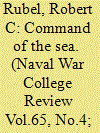

|
|
|
|
|
| Publication |
2012.
|
| Summary/Abstract |
the trade of the world commands the riches of the world and consequently the world itself. For in war . . . the common sense of some and the genius of others sees and properly applies means to ends; and naval strategy, like naval tactics, when boiled down, is simply the proper use of means to attain ends. But in peace, as in idleness, such matters drop out of mind, unless systematic provision is made for keeping them in view.
The last great sea battle occurred in 1944. Since then the world ocean has been open to free navigation by all nations as a matter of American policy. The ability to enforce this policy-or perhaps better said, the absence of serious challenges to this policy-has been in significant part a product of the superiority of the U.S. Navy. Despite a latent and partial challenge during the Cold War by the Soviet navy, since World War II the degree and persistence of U.S. Navy superiority have led most people to take it for granted and have caused the old term "command of the sea" virtually to disappear from the naval lexicon.1 However,
the emergence of a powerful Chinese navy and an associated land-based seadenial force is stimulating a new focus on sea control and overcoming antiaccess/ area-denial efforts. New concepts, such as "AirSea Battle," are being developed and investments made in platforms, weapons, and systems. This activity is critical to American strategic interests and prospects, and it must be informed by an understanding of command of the sea as a foundational concept of sea power. A reconsideration of command of the sea is all the more necessary as political, economic, and technological developments have significantly changed the nature of how sea power influences the dynamics of geopolitical interactions. This article will argue for an extended definition of the term and its renewed application to naval strategy and doctrine.
|
|
|
|
|
|
|
|
|
|
|
|
|
|
|
|
| 2 |
ID:
186395
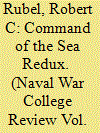

|
|
|
|
|
| Summary/Abstract |
Maritime strategy—the application of a nation’s sea power to achieve its
political ends—can be a complicated, multilayered affair, especially for a
great power such as the United States. American maritime strategy’s complex, and
frankly esoteric, nature is exacerbated by the country’s fragmented, “stovepiped”
military and other governance structures. No single agency has the responsibility,
authority, and perspective both to develop and to execute the country’s maritime
strategy. Thus we observe the clashes between the U.S. Navy and Congress, in
which legislators override both the Navy and the Secretary of Defense, taking
control of naval shipbuilding plans.1
Recently, despite the issuance by the Navy,
Marine Corps, and Coast Guard of the strategy document Advantage at Sea,
Congresswoman Elaine G. Luria (D-VA) felt compelled to write a post calling for
a new maritime strategy of the sort the Navy developed in the 1980s.
|
|
|
|
|
|
|
|
|
|
|
|
|
|
|
|
| 3 |
ID:
189572
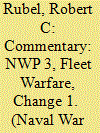

|
|
|
| 4 |
ID:
146371
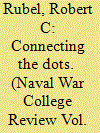

|
|
|
|
|
| Summary/Abstract |
An announcement in 2013 by then–Secretary of Defense Chuck Hagel that the Navy might reduce its aircraft carrier fleet from eleven to eight was an indication not only of harsh budget realities but also of changed operational circumstances at sea. 1 In World War II, the aircraft carrier displaced the big-gun battleship as the capital ship. The United States subsequently used its fleet of aircraft carriers to exercise the command of the sea that it had won in the war to secure the peace.
|
|
|
|
|
|
|
|
|
|
|
|
|
|
|
|
| 5 |
ID:
171600
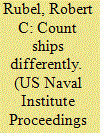

|
|
|
| 6 |
ID:
138697
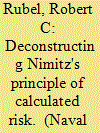

|
|
|
|
|
| Summary/Abstract |
All military operations are attended by various forms of risk. Risk permeates the fabric of war—from the actions of individual soldiers, sailors, and airmen to the policies, strategies, and decisions of national leaders. Decisions and actions have both potential and real consequences, and intelligent decision making normally involves a calculation of the odds for success and failure, as well as consideration of the consequences of potential failure. When success is less than a sure thing but through analysis of the salient aspects of the problem, including costs and consequences of failure, a commander decides to proceed nonetheless,
we can say that he is taking a “calculated risk.
|
|
|
|
|
|
|
|
|
|
|
|
|
|
|
|
| 7 |
ID:
073423
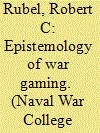

|
|
|
| 8 |
ID:
074007
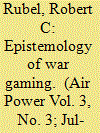

|
|
|
| 9 |
ID:
159095
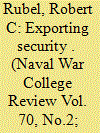

|
|
|
|
|
| Summary/Abstract |
Viewing geography differently and borrowing concepts from the business world can help clarify
China’s mode of developing its international relationships, why that mode so disturbs the United
States, and what the effect might be on the global power structure.
|
|
|
|
|
|
|
|
|
|
|
|
|
|
|
|
| 10 |
ID:
115002
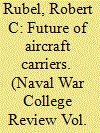

|
|
|
|
|
| Publication |
2011.
|
| Summary/Abstract |
The aircraft carrier has been around in various forms since the First World
War. Its emergence as the key denominator of naval power is legendary, and
its continuing prestige in this role is even yet spawning building programs
among established and growing navies. The aircraft carrier is the largest and
most complex of all warships and in most cases the most expensive. In addition
to the cost of the ship itself, that of the embarked air wing must be considered,
not to mention the extensive logistics and training infrastructure needed to keep
carriers operating and useful. A recent Naval Postgraduate School study has
shown that approximately 46 percent of the Navy's personnel-officer, enlisted,
and civilian-are assigned to positions either on or supporting its carriers.
1
For
these and other reasons, there has been almost constant debate over the past
ninety years within navies, between navies and air forces, and within governments over the advisability of investing in carriers. As the prospects for major
cutbacks in defense spending loom, the debate will again heat up. Both proponents and opponents of carriers have refined their arguments over the past nine
decades, but these are now starting to wear thin as the geopolitical environment
and the technology of war have changed. Also, the arguments both for and
against have tended toward the theological, with many tacit or unacknowledged
assumptions underpinning the argumentative maneuvers. In an attempt to improve the quality of the coming debates, this article will examine the prospects
for future utility of the ship type, including that of the embarked air wing, from
a different angle. Instead of making a holistic judgment on the future utility of
aircraft carriers, it will focus on the ways they have been, are, or could be used.
|
|
|
|
|
|
|
|
|
|
|
|
|
|
|
|
| 11 |
ID:
118308
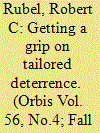

|
|
|
|
|
| Publication |
2012.
|
| Summary/Abstract |
The assumption that the United States operates from a position of strength relative to its potential enemy underpins U.S. deterrence theory. This perceived strength has emboldened American administrations to take serious tactical risks, such as the positioning of aircraft carriers in the Eastern Mediterranean during the 1973 Yom Kippur War in order to dissuade Soviet intervention in that conflict. This tacit assumption, facilitated and entrenched by overwhelming U.S.conventional military superiority in the post-Cold War era, forms the foundation both for the relatively recent developmentof tailored deterrence and for the "Flexible Deterrence Options" (FDO) that now constitute a routine aspectof the joint military planning process. This article argues that the tacit assumption of strength is too narrow and can promote the implementation of deterrent policies and actions that have the opposite effects of those intended. Deterrence, rightly understood, is a component of a conflict management strategy which implies a degree of weakness on the part of the statethat employs it. This condition must be recognized and then incorporated into policies and plans for deterrence.
|
|
|
|
|
|
|
|
|
|
|
|
|
|
|
|
| 12 |
ID:
159132
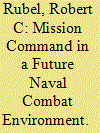

|
|
|
|
|
| Summary/Abstract |
Naval officers must understand the considerations required to exert effective mission command as
operations devolve into forms characterized by lesser degrees of structure and control.
|
|
|
|
|
|
|
|
|
|
|
|
|
|
|
|
| 13 |
ID:
133373
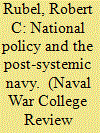

|
|
|
|
|
| Publication |
2014.
|
| Summary/Abstract |
The article discusses U.S. government policy concerning the U.S. Navy during what is called the post-systemic era. The author argues that the U.S. Navy requires recapitalization, states that the U.S. Navy must craft a clear strategic concept to convince the U.S. public that it should receive continued funding, and discusses the constitutional role of the U.S. Navy. The article discusses former U.S. secretary of the treasury Alexander Hamilton, scholar Alfred Thayer Mahan, and the U.S. Navy during the Cold War.
|
|
|
|
|
|
|
|
|
|
|
|
|
|
|
|
| 14 |
ID:
087261
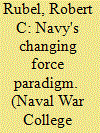

|
|
|
| 15 |
ID:
159086
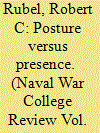

|
|
|
|
|
| Summary/Abstract |
There has occurred of late a controversy of sorts regarding the vector of
investment by the U.S. Navy. Secretary of Defense Ash Carter overruled
certain aspects of the Navy’s fiscal year 2016 budget, directing funds away from
presence-related items such as the littoral combat ship (LCS) and toward highend
combat capabilities such as the F-35.1
Chief of Naval Operations (CNO)
Admiral John Richardson categorized the ensuing debate about the functions of
presence versus high-end military posture as a “false choice,” asserting that the
Navy must provide both in a balanced manner.2
However, in an era of budget
squeezes, marginal trade-offs meant to solve the problem, such as Carter’s Navy
budget alterations, could result in a Navy that will be able to provide neither to
a sufficient degree. Decisions on “fleet design” should be informed by an understanding
of the relationship between forward engagement, in all its forms, and
combat posture.3
Regarding these two functional elements of the Navy’s mission
as either mutually exclusive or having a primary/collateral relationship is a recipe
for strategic error.
|
|
|
|
|
|
|
|
|
|
|
|
|
|
|
|
| 16 |
ID:
130067
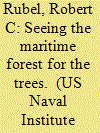

|
|
|
|
|
| Publication |
2014.
|
| Summary/Abstract |
In this article, the author ponders on a strategy document that will be released by the U.S. Navy in 2014, succeeding a 2007 document titled A Cooperative Strategy for 21st Century Seapower (CS21). Topics discussed include the prospects for a congressional deal on the defense budget that was discussed during a U.S. Naval Institute conference in 2013 and the features of Eurasian continental powers. Also mentioned is the correlation between continental powers and maritime strategy
|
|
|
|
|
|
|
|
|
|
|
|
|
|
|
|
| 17 |
ID:
130427
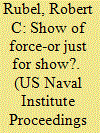

|
|
|
| 18 |
ID:
122027
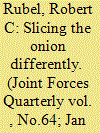

|
|
|
| 19 |
ID:
138681
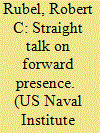

|
|
|
| 20 |
ID:
100664
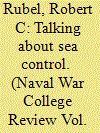

|
|
|
|
|
| Publication |
2010.
|
| Summary/Abstract |
The year 1990 was a significant one in naval history. It marked the transition from a world in which the oceans were contested to one in which one navy had uncontested command of the sea. The evidence for this shift is that during the run-up to the first Gulf War with Iraq, the U.S. Navy positioned half of its total aircraft carrier striking power in narrow seas, splitting it between the Red Sea and the Persian Gulf. If there was any conceivable threat, such a move would have constituted strategic Russian roulette. The incipient demise of the Soviet Union and the evaporation of its fleet, along with Iran's decision to stand aside, made the only threat to U.S. ships the stub oil platforms in the Persian Gulf and some mines in the gulf's northern reaches.
|
|
|
|
|
|
|
|
|
|
|
|
|
|
|
|
|
|
|
|
|